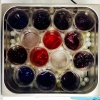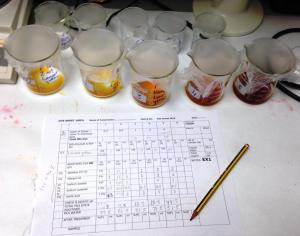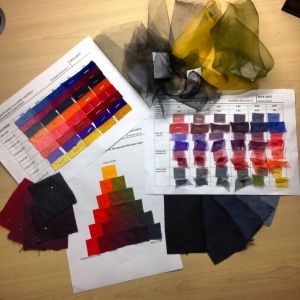
by Freya Gabbutt, First year student, MPhil Textile Conservation.
In preparation for our Introduction to Dyeing at the end of the first semester of first year I experimented with dyeing my hair. Apart from a transformation in colour and the propensity of dye to stain every surface it touches, I have decided they have little in common.
Dyeing in textile conservation is used for colour matched threads, support fabrics and infills to use in conservation treatments. Conservation requires extreme accuracy and recording to ensure reproducibility, light & water fastness and the need to create a range of colours to match an object (much more than my slap-dash ‘stick-it-on-and-hope-for-the-best’ approach to hair dye). It surprised my family to hear we use synthetic dyes but they are used precisely because they best fit these criteria.
Sarah Foskett beautifully described dyeing as ‘hard chemistry with a touch of magic’. The process requires precision in calculating ratios, measuring quantities and following an exacting time and temperature cycle. On the other hand, there is a certain je ne sais quoi about dyeing that cannot be simply calculated; the art of how to and how much to stir to prevent splotchiness but also not to mangle the fabric sample in the process. A lovely analogy of a former CTC graduate likened it to the stirring of risotto – gentle and constant. Also like a risotto, dyeing is a lengthy process which cannot be left by itself– dyeing a set of samples usually takes about a morning of stirring and standing over a steaming bain-marie full of wee pots of ‘dye liquor’. As a self-confessed chemistry improver, measuring out water, dye and additives using pipettes to ensure accuracy takes almost as long!
Over the course of 5 days we did three sets of sample dyeing. We have started to build up our dye repertoire to familiarise us with the calculations, processes and materials; dyeing different fabrics (silk crepeline, nylon net, wool and cotton), sampling colour density, colour mixing with two and three colours and trialling two different dye types (Lanaset® for protein fibres and Novacron® for cellulosics).
It was an extremely informative and thoroughly enjoyable few days, learning a technique which we are sure to use again and again. I only wished I had saved my hair colouring for after the course – if I had, I’m sure I would have got the lilac hue I was looking for the first time round!




